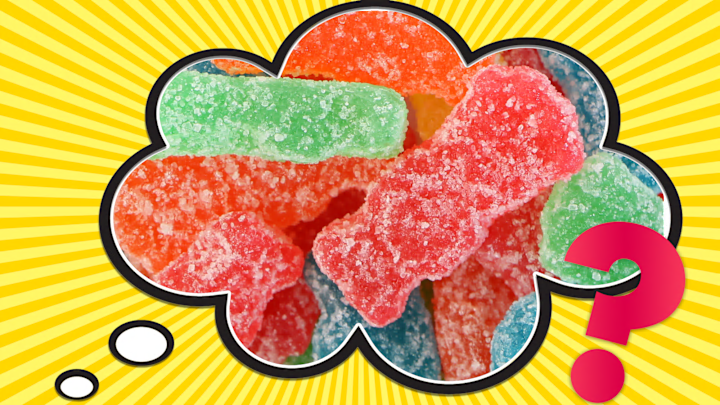There's nothing subtle about the flavor of sour candy. Whether you prefer Sour Patch Kids or sour gummy worms, one bite of the stuff produces an eye-watering, mouth-puckering sensation that oscillates between addictive and unbearable. The same flavor occurs naturally in fruits like lemons and limes, but how do candy manufacturers pack the tart taste into their processed treats?
According to Mashed, when your taste buds react to sour candy, what you're really tasting is acid. Acid can develop in fruit or dairy that has spoiled, and the strong reaction we have when it hits our tongue is our body's way of warning us that what we're eating could be harmful. Humans aren't born liking acerbic things, but like with bitterness and spice, they can grow to love the flavor through acquired taste.
Citric acid, which occurs naturally in citrus fruits, appears in the ingredient list of most sour snacks. To make this candy taste so sharp, food makers manufacture their own citric acid. They do this by feeding sugar to microorganisms, which then expel an acidic byproduct in a process called fermentation.
Malic acid is another common component of sour candy. In nature, it appears in fruits like apples and tomatoes, and it's less piquant compared to citric acid. Candy companies take advantage of its relatively mild flavor by coating it in hydrogenated palm oil. As the oil dissolves in your mouth, it acts as a time-release mechanism, creating a "slow burn" effect that complements that citric acid's explosive punch.
The fastest way to deliver the biting sensation candy lovers crave is to load it onto the surface of the treat. The sand-like coating you see on the outside of many sour gummies—including Sour Patch Kids, Sour Punch Straws, and Trolli Sour Brite Crawlers—consists of acid or blends that contain it. These might contain a combination of different acids, including tartaric, lactic, and fumaric acid, as well as citric and malic acid. By concentrating the key ingredient on the candy's surface, consumers are guaranteed to get a flavor rush the moment it enters their mouth.
There's one more ingredient that's essential to your sour-candy binge, and you won't find it listed on the back of the box. Saliva plays an important role in the puckering feeling that overwhelms your senses. When an acid combines with saliva, the acid releases hydrogen ions, which our tongues flag as sour. That's why holding a sour candy on your tongue, prolonging the chemical reaction, can increase its perceived intensity.
Have you got a Big Question you'd like us to answer? If so, let us know by emailing us at bigquestions@mentalfloss.com.
